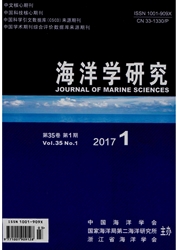

 中文摘要:
中文摘要:
利用2007年10月和2009年6月对长江口及邻近海域表层沉积物的监测数据,分析了其中Cu、Pb、Zn、Cd、Cr、As和Hg等7种重金属元素和TOC的含量,并采用Hakanson生态风险指数法进行了潜在生态风险评价。结果表明:重金属Cu、Pb、Zn、Cd、Cr、As和Hg元素的平均含量分别为:37.43×10^-6,36.85×10^-6,93.48×10^-6,0.17×10^-6,72.91×10^-6,10.60×10^-6和0.043×10^-6。各重金属元素空间上呈现长江口及杭州湾高、外陆架海区低的分布趋势,且总体上调查海区南部海域高于北部海域。7种重金属元素的污染指数由大到小排序为:Cu〉Cr〉Zn〉Pb〉As〉Cd〉Hg,其中Cu和Cr元素是主要的污染因子;潜在生态风险系数由大到小依次为:Cd〉Hg〉Cu〉As〉Pb〉Cr〉Zn,其中Cd、Hg和Cu元素是主要的潜在生态风险因子。研究区仅局部海域受到了重金属元素的污染,RJ值均小于150,属低潜在生态危害的范畴。
 英文摘要:
英文摘要:
According to the monitoring data on Changjiang River Estuary and its adjacent sea areas' sediments in October 2007 and June 2009, heavy metals (Cu, Pb, Zn, Cd, Cr, As, Hg) and TOC in the sediments of those areas were studied. The method of Potential Ecological Risk Index techniques presented by Hakanson was used to assess the potential ecological risk of heavy metals. The average contents of Cu, Pb, Zn, Cd, Cr, As, Hg were 37.43×10^-6 36.85×10^-6 93.48×10^-6 0.17×10^-6, 72.91×10^-6 10. 60 ×10^-6 and 0.043 ×10^-6 respectively. In general, the distribution of heavy metals show that it was high in Changjiang River Estuary and Hangzhou Bay, but lower at the outer continental shelf waters. Overall, the contents of heavy metals were higher in the south sea areas than those in the north sea areas. The sequences of the heavy metals pollution index of the studied metals were Cu〉Cr 〉Zn〉Pb〉As〉Cd〉Hg, Cu and Cr were the main pollution factors; the order of potential ecological risk were Cd〉Hg〉Cu〉As〉Pb〉Cr〉Zn, Cd, Hg and Cu were the main potential ecological risk factors. Thus, it can be seen that just parts of the study area were polluted by the heavy metals. They were also low potential ecological risk with the potential ecological risk indeices less than 150.
 同期刊论文项目
同期刊论文项目
 同项目期刊论文
同项目期刊论文
 期刊信息
期刊信息
